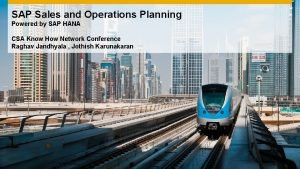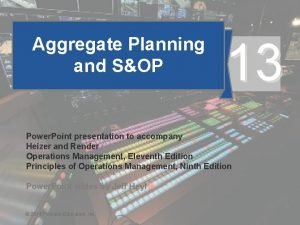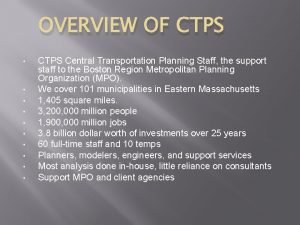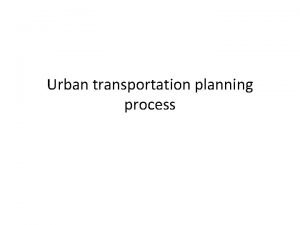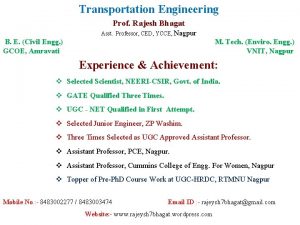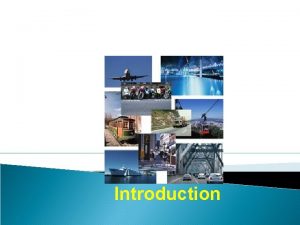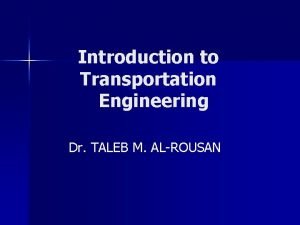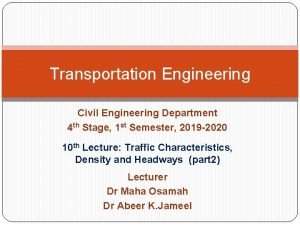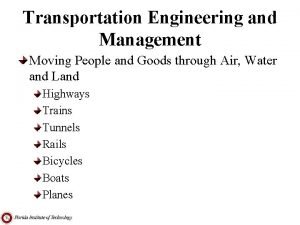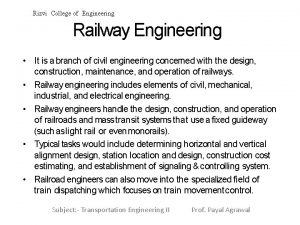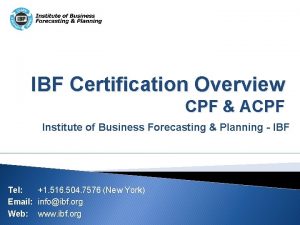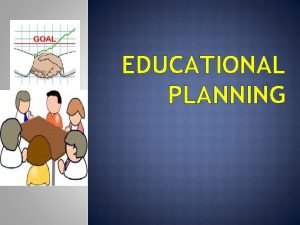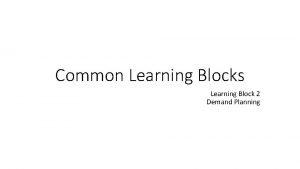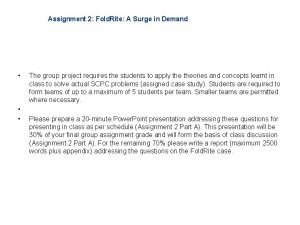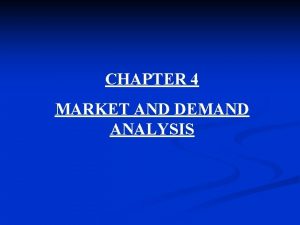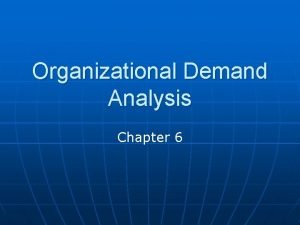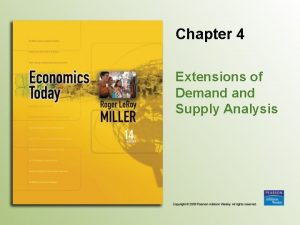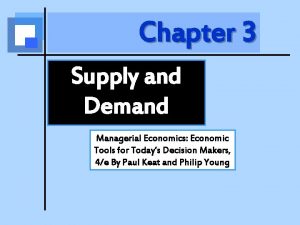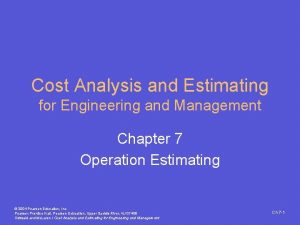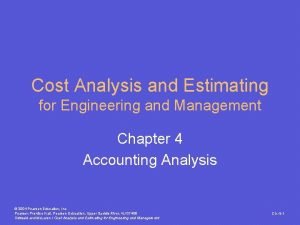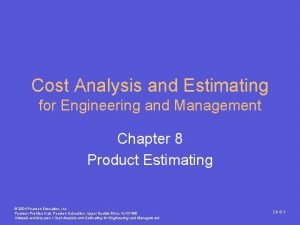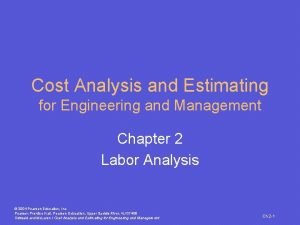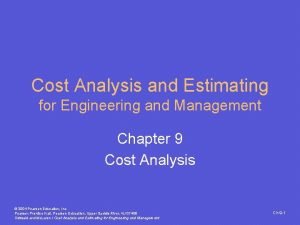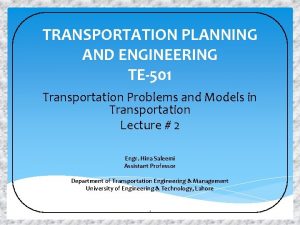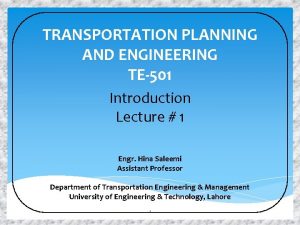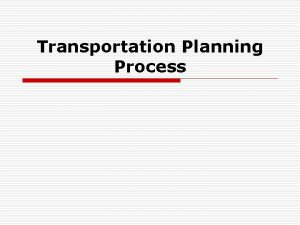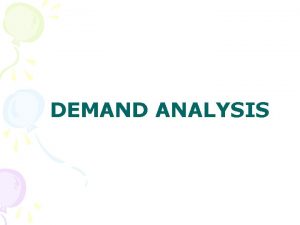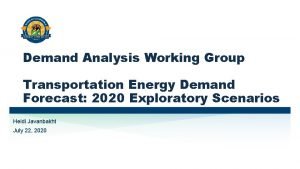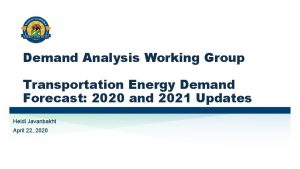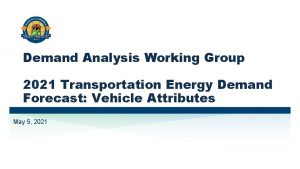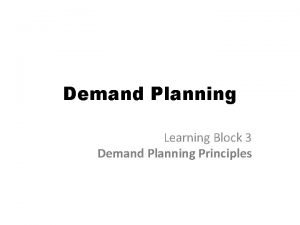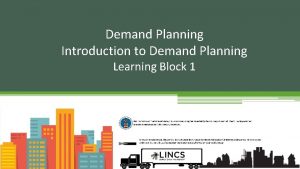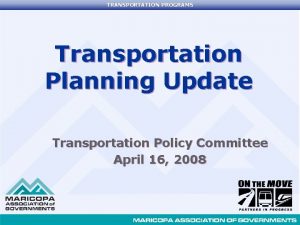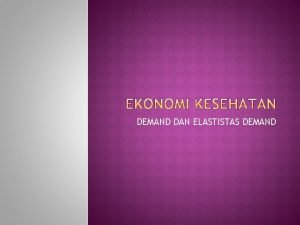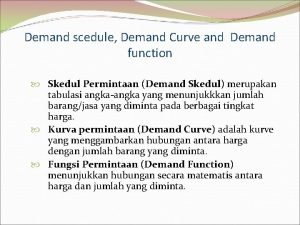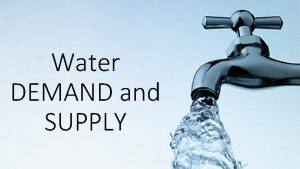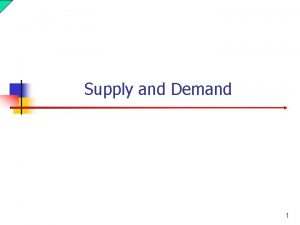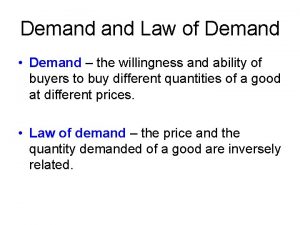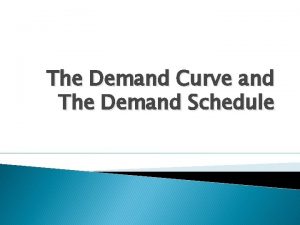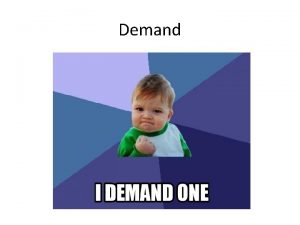TRANSPORTATION PLANNING AND ENGINEERING TE501 Transportation Demand Analysis









































- Slides: 41

TRANSPORTATION PLANNING AND ENGINEERING TE-501 Transportation Demand Analysis Lecture # 3 Engr. Hina Saleemi Assistant Professor Department of Transportation Engineering & Management University of Engineering & Technology, Lahore 1

Lecture Outline § § § Aggregate vs. Disaggregate Analysis Surveys Transportation Demand Analysis Four-Step Transportation Modeling System Step 1: Trip Generation

Survey Data § Origin-Destination (O-D) surveys § Ask questions about each trip made on a specific day Where the trip begins and ends § Purpose of the trip § Time of day trip is made § Mode used to make the trip (vehicle, transit) § Characteristics of person (gender, age, income, vehicle owner, etc.

Travel Diary Summarize the number of trips by mode, by purpose, by time of day, etc. To do so, for each trip record the following information: • Start and end time • Start and end location of each trip, • Primary mode (drive alone, car driver with passenger, car pooling, bus, walk, bike, other) • Purpose (to work, return home, work related business, shopping, family/personal business, school, medical/dental, vacation, visit friends or relatives, social recreational, other)

Travel Diary • Break into groups and assess the travel diary data. • What factors most strongly influence trip-making? • What model best predicts trip-making behavior?

Survey Procedures • External Surveys: Provide information on trips that either pass through the zone or have one trip end outside the zone • Internal Surveys: Provide information on trips made by residents of an area

External Surveys • • • Cordon Surveys Roadside interviews License plate surveys Postcard/mail-back surveys Study area Entire urbanized area Transportation study area City CBD An industrial area

External Surveys Cordons should; § Define the study area/area of interest. § Define area useful for planning purposes.

Internal Surveys § § § Dwelling-unit interviews. Vehicle owner mail questionnaires. Interviews at workplaces and special generators. Transit route passenger questionnaires. Truck and taxi surveys.

Transportation Demand Analysis § § § § § User Costs Cost of Automobile Operating and Maintenance Cost Tolls Value of Time (time spent in travel) Monetary Value of Time Travelers’ willingness to pay for reduced travel time Purpose of trip Time saved

Transportation Demand Analysis § § § § Trip-Making Characteristics Trip Purpose Time of day Origin and destination of the trip Mode of travel Route Frequency

Aggregate Vs Disaggregate Analysis Zonal-Based (Aggregate models) § Zone as the smallest entity of interest for trip making Zonal characteristics (Population, Average income, Average vehicle ownership) Household-Based (Disaggregate models) § Disaggregate each zone into smaller units

Travel Demand Forecasting Travel demand- number of persons or vehicles per unit time expected to travel on a given route under a set of conditions: § Land use § Socio-economic § Environmental

What Travel Decisions can be Modeled Forecasts should be based on some understanding of traveler decisions. There are four distinct, but interrelated, decisions regarding trips: § The choice and reason to travel § The destination of travel § The mode by which to travel § The route on which to travel

Four Step Travel Demand Model These four decisions are the basis of the traditional fourstep travel demand model § Sequential demand model § Outputs of each step become inputs to the following step § Originally developed in the 1950’s and 1960’s when planning major highway facilities

Four Step Travel Demand Model 1. TRIP GENERATION How many trips will be generated by a given location and when will these trips occur? 2. TRIP DISTRIBUTION What are the origins and destinations of these trips? 3. MODE CHOICE Which mode of transportation will be used to make the trip? 4. TRAFFIC ASSIGNMENT Which route on the transportation network will be used when making the trip?

Four Step Travel Demand Model (FSTDM) Demographic Data Step 1: Trip Generation Transportation Network Step 2: Trip Distribution Step 3: Mode Choice Step 4: Trip/ Traffic Assignment

Trip Generation Questions • How much do people use the transport system? • Why do people use the transport system? • Where can different types of activities be satisfied?

Trip Distribution Questions • Given a location, where do people go to satisfy demand for an activity type?

Mode choice Questions • How do people use the transport system? • What modes do they choose? • How do they react to varying transport service quality?

Trip / Traffic Assignment Questions • How do people use the transport system? • • Given a mode, which route do they choose? Do they satisfy multiple activities in one tour? Which parts of the transport system do they use? How do they react to varying transport service quality?

Demographic Data • Autos per household • Income level • Household size

Network Data • Highway network • Transit network

Example of Four Step Model

What Factors Influence Travel Demand Location and intensity of land use (Residential, Industrial, Commercial, Office, Institutional/Civic, Parks/Open Space, Extent, cost and quality of available transportation services) Socioeconomic characteristics of study area § Population Forecasts § Economic Forecasts § Land Use Forecasts

STEP 1 : Trip Generation

Trip Generation § Process of determining the number of trips that will begin or end in each traffic zone within a study area Each trip has two ends. § Described in terms of trip purpose or whether the trips are either produced by a zone or attracted to a zone

Trip Generation Ø Trip Purposes Home-Based Work (HBW, H 2 W, W 2 H) § Trips between home and work § Home-Based Other (HBO, H 20, O 2 H) § Trips between home and other places such as shopping or recreation Non-Home Based (NHB, W 2 O, O 2 W, O 2 O) § Trips that do not involve the home

Trip Generation § Purpose is to establish relationships between variables that predict the amount of traffic a part of land will produce or attract § Data may be aggregated at zonal level or at household level § Based on characteristics of the trip-makers § Age, gender, income, auto ownership, etc

Trip Generation • Trip generation is the process of determining the number of trips that will begin or end in each TAZ within a study area. • It is the first step of the four-step modelling procedure and is very important since it sets up: i. The framework for the following tasks, and also ii. The controlling values such as the total number of trips generated in the study area by location and trip purpose.

Trip Generation (contd. ) Trip? A trip, for the purpose of analysis, is defined as a one-way movement from an origin to a destination. Origin Destination Each trip has two ends, and these are described in terms of trip purpose, or whether the trips are either produced by a traffic zone or attracted to a traffic zone. For example, a home-to-work trip would be considered to have a trip end produced in the home zone and attracted to the work zone.

Trip Generation Analysis • Two types of trip generation analysis are carried out, and these are referred to as, • Trip production analysis, and • Trip attraction analysis

Trip Generation Analysis (contd. ) • The term trip production refers to the trips generated by residential zones, where these trips may have trip origins or trip destination. • The term trip attraction is used to describe trips generated by activities at the non-home end of trips.

Trip Classification • Urban travel demands are made up of a number of different trip types that have specific spatial and temporal characteristics. • The first level of trip classification, used normally, is a broad grouping into, • Home based trips; trips that have one trip end at a household • Non-home based trips; e. g. trips b/w work place and shopping area, business trips b/w two activity centres, etc.

Trip Classification Total Trips = 8 4 trip ends are produced at zone 1 6 trip ends are attracted to zone 2 2 trip ends are produced at and 4 trip ends are attracted to zone 3.

Trip Generation Analysis • Simply, trip generation analysis has two functions: • The goal of trip generation models for internal passenger trips is to estimate total number of ‘trip ends’ for each purpose generated in each traffic zone based on socio-economic and/or land use data for the respective zones. • To use the relationship to estimate the number of trips generated at some future date under a new set of land use conditions.

Trip Generation Analysis (contd. ) • This task can be accomplished with either aggregate or disaggregate models. • For aggregate models the total number of trips (trip ends) generated in a zone is used as the dependent variable. • For disaggregate models trips made by a household (or a business establishment) is used as the dependent variable. When using disaggregate models the trip ends generated by households, and/or any other trip generating units such as business establishments, in a zone are combined to produce the zonal (total) value.

Trip Generation Analysis (contd. ) 1. Cross-Classification disaggregate models 2. Rate Based Analysis 3. Multiple Regression Analysis – aggregated model - household generated trips comprise a major portion of all trips in an urban area (more than 80%).

LAB WORK 4 System Descriptive Model Traffic Counts at Closed Loop (Real Time Problem) 39

Traffic count at 4 Intersection 1. 2. 3. 4. Garhi Shahi Intersection Butt Sweets Intersection Queen Marry Intersection Cakes and Bakes Intersection 40

Any Questions 41
 Module 5 supply and demand introduction and demand
Module 5 supply and demand introduction and demand Measures to correct deficient demand
Measures to correct deficient demand Dependent demand inventory example
Dependent demand inventory example Mga halimbawa ng demand
Mga halimbawa ng demand Demand forecasting in managerial economics
Demand forecasting in managerial economics Distinguish between individual demand and market demand
Distinguish between individual demand and market demand Dependent demand items
Dependent demand items Deterministic and stochastic inventory models
Deterministic and stochastic inventory models Individual demand vs market demand
Individual demand vs market demand Independent demand example
Independent demand example Sap sales and operations planning
Sap sales and operations planning Transportation method of aggregate planning
Transportation method of aggregate planning Central transportation planning staff
Central transportation planning staff Urban transportation act of 1964
Urban transportation act of 1964 Scope of traffic engineering
Scope of traffic engineering About the bed
About the bed Definition of transportation
Definition of transportation Transportation engineering definition
Transportation engineering definition Transportation engineering
Transportation engineering Transportation engineering
Transportation engineering Transportation engineering
Transportation engineering Ibf cpf
Ibf cpf Importance of educational planning
Importance of educational planning Building blocks demand planning
Building blocks demand planning Replenishment forecasting
Replenishment forecasting Foldrite furniture company case solution
Foldrite furniture company case solution Proactive planning and reactive planning
Proactive planning and reactive planning Long medium and short term planning in primary schools
Long medium and short term planning in primary schools Corpus planning definition
Corpus planning definition Forward engineering in software engineering
Forward engineering in software engineering Desire on demand
Desire on demand Market and demand analysis
Market and demand analysis Ap macroeconomics supply and demand analysis
Ap macroeconomics supply and demand analysis What is market demand
What is market demand Organizational demand
Organizational demand Extensions of demand and supply analysis
Extensions of demand and supply analysis Determinants of demand in managerial economics
Determinants of demand in managerial economics Cost analysis and estimating for engineering and management
Cost analysis and estimating for engineering and management Cost analysis and estimating for engineering and management
Cost analysis and estimating for engineering and management Cost analysis and estimating for engineering and management
Cost analysis and estimating for engineering and management Cost analysis and estimating for engineering and management
Cost analysis and estimating for engineering and management Cost analysis and estimating for engineering and management
Cost analysis and estimating for engineering and management










